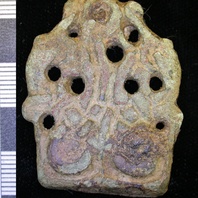
Viking Objects
Stirrup Mount (LEIC-C97582)
This example of a copper-alloy stirrup-strap mount is decorated with an interlaced design forming two ‘serpents’ interrupted by nine circular holes. It is similar to mounts of William Class A Type 1 but the holes and its large size match Class C mounts more closely.
Read More
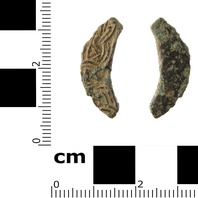
Viking Objects
Copper-Alloy Buckle Fragment (SWYOR-1F57BC)
This copper-alloy fragment is probably part of a flat buckle-frame decorated with Borre-style interlace though very few comparable examples exist.
Read More
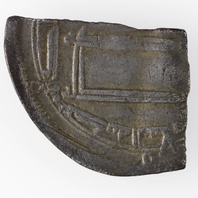
Viking Objects
Abbasid Silver Dirham (CM_773_2008)
This coin was minted at al-‘Abbasiyya. The dirham was a unit of weight used across North Africa, the Middle East, and Persia, with varying values which also referred to the type of coins used in the Middle East during the Viking Age. These coins were extremely prized possessions not only for their silver value but as a way of displaying ones wealth and vast trade connections. Millions of Arabic Dirhams would have been imported throughout the Viking world and are mostly found in hoards. Reduction in access to silver coins like this is thought to have been one of the causes of the Viking Age.
Read More
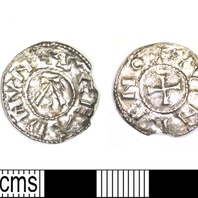
Viking Objects
St Edmund Penny (LEIC-4FC58C)
Between 895 and 915, Scandinavian settlers in East Anglia minted a series of pennies and half pennies with the inscription SCE EADMVND REX (St Edmund the king). These coins appear to have been used widely throughout the Danelaw, and a large number of them were discovered in the Cuerdale Hoard from Lancashire. This coin appears to have been made with a poorly engraved die and features a blundered inscription naming the moneyer. The Portable Antiquities Scheme suggests that the moneyer’s name was Winegar. The inscription reads YVINRE NO.
Read More
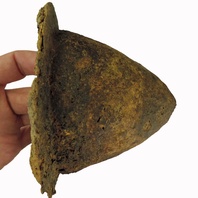
Viking Objects
Shield Boss (1989-59/9013)
This is a probable Viking shield boss from Repton, Derbyshire. This shield boss is possible evidence for the Viking Great Army’s overwintering at Repton in 873. The typical construction of a ‘Viking’ shield at the time involved several wooden planks glued together and cut into a circle. The face of the shield was then covered in linen or rawhide with rawhide edging that was either tacked or sewn on. Finally, a metal boss would be attached along with the handle over a hole in the centre. The purpose of the metal boss was to protect the user’s hand in combat.
Read More
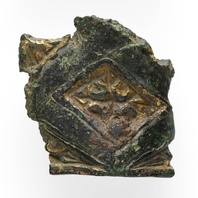
Viking Objects
Broken Gilt Vessel (CM.1822.2008)
A broken gilt vessel fragment decorated with a Carolingian motif within a repeated diamond pattern. A single iron rivet provides evidence that this vessel might have been repaired and reused. The vessel will have been brought from Francia to Torksey, Lincolnshire, where it was found, perhaps by a member of the Great Heathen Army or its train.
Read More
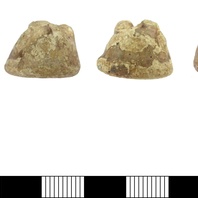
Viking Objects
Cast Lead-Alloy Gaming Piece (DENO-646EE0)
A complete cast lead-alloy early medieval gaming piece. This and similar pieces have also been interpreted as weights although the gaming piece interpretation is more secure. Pieces like this would have been used to play hnefatafl and/or Nine Men’s Morris, both of which are known to have been played in Scandinavia in the Viking Age.
Read More
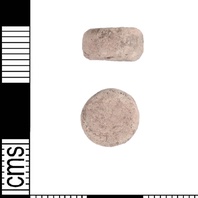
Viking Objects
Round Lead Weight (PUBLIC-2DDD03)
Weights are an important form of evidence for Viking Age commerce and the use of standards across the different economic systems within which Vikings were integrated. Many of the weights discovered, particularly ones in Ireland and those of Arabic type, suggest that a standardized system of weights existed in some areas. These standard weights, alongside standard values of silver, are what allowed the bullion economy of Viking occupied areas to function. A bullion economy was a barter economy that relied on the exchange of set amounts of precious metal in various forms, such as arm-rings or coins, for tradable goods, such as food or textiles. Each merchant would have brought their own set of weights and scales to a transaction to make sure that the trade was conducted fairly.
Read More
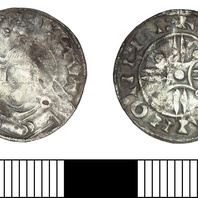
Viking Objects
Coin of Cnut the Great (DENO-28F8A6)
This silver penny is a posthumous issue of Cnut, with arm and sceptre obverse type, minted by Thurgrim in Lincoln under the authority of King Harthacnut. Minting coins was a way of controlling the means of exchange within a kingdom and which created a more easily administered standardized system of trade. Moreover, the coins themselves were often used as propaganda, portaying symbols and statements that gave off a desired message. The Vikings later used the minting of coins to legitimize their own rule.
Read More
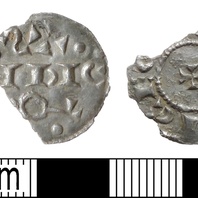
Viking Objects
Incomplete Viking Silver Penny (DENO-7A0AF7)
An incomplete silver early medieval penny of the Vikings influenced by the Swordless St Peter type and possibly minted in the name of Sihtric Caoch who ruled Dublin between 917-920 CE and was King of Northumbria from 921-927 CE. It is not certain why he left Ireland. The Irish annals state that it was ‘through the grace of God’ and do not elaborate on the politics behind his departure. After the establishment of the Danelaw, some Viking leaders decided to mint their own coins to solidify their legitimacy in the eyes of the local populace. This created a hybrid economy where some members of the Danelaw used bullion and others used coins.
